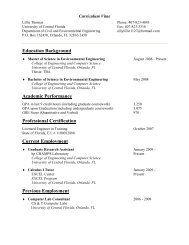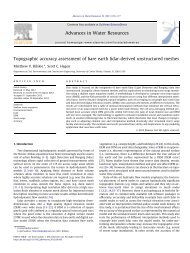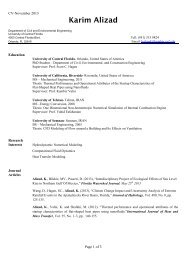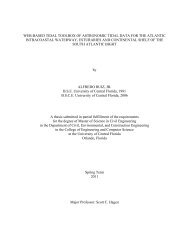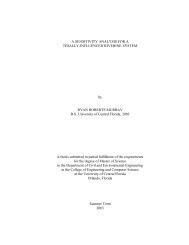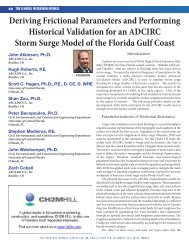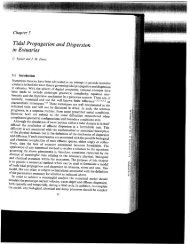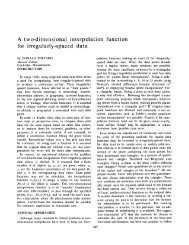Compatible algorithms for coupled flow and transport
Compatible algorithms for coupled flow and transport
Compatible algorithms for coupled flow and transport
You also want an ePaper? Increase the reach of your titles
YUMPU automatically turns print PDFs into web optimized ePapers that Google loves.
<strong>Compatible</strong> <strong>algorithms</strong> <strong>for</strong> <strong>coupled</strong> <strong>flow</strong> <strong>and</strong> <strong>transport</strong> q<br />
Clint Dawson * , Shuyu Sun, Mary F. Wheeler<br />
Center <strong>for</strong> Subsurface Modeling-C0200, Texas Institute <strong>for</strong> Computational Engineering <strong>and</strong> Sciences, The University of Texas at Austin,<br />
Austin, TX 78712, USA<br />
Received 10 April 2003; received in revised <strong>for</strong>m 7 November 2003; accepted 18 December 2003<br />
Abstract<br />
The issue of mass conservation in numerical methods <strong>for</strong> <strong>flow</strong> <strong>coupled</strong> to <strong>transport</strong> has been debated in the literature<br />
<strong>for</strong> the past several years. In this paper, we address the loss of accuracy <strong>and</strong>/or loss of global conservation which can<br />
occur when <strong>flow</strong> <strong>and</strong> <strong>transport</strong> schemes are not compatible. We give a definition of compatible <strong>flow</strong> <strong>and</strong> <strong>transport</strong><br />
schemes, with emphasis on two popular types of <strong>transport</strong> <strong>algorithms</strong>, the streamline diffusion method <strong>and</strong> discontinuous<br />
Galerkin methods. We then discuss several different approaches <strong>for</strong> <strong>flow</strong> which are compatible with these<br />
<strong>transport</strong> <strong>algorithms</strong>. Finally, we give some numerical examples which demonstrate the possible effects of incompatibility<br />
between schemes.<br />
Ó 2004 Elsevier B.V. All rights reserved.<br />
Keywords: Flow; Transport; Mass conservation; Streamline diffusion method; Discontinuous Galerkin methods<br />
1. Introduction<br />
Comput. Methods Appl. Mech. Engrg. 193 (2004) 2565–2580<br />
The <strong>transport</strong> of chemically reactive species arises in a number of important applications. Specific<br />
examples include groundwater contamination, water quality modeling <strong>and</strong> air quality modeling. This<br />
physical process is described by advection–diffusion–reaction systems.<br />
The advection <strong>and</strong> diffusion of chemical species are governed by a velocity field, which is generally given<br />
by a <strong>flow</strong> model. The <strong>flow</strong> model is application-dependent, <strong>and</strong> may be described, <strong>for</strong> example, by Darcy<br />
<strong>flow</strong> in the subsurface, a hydrodynamic model in shallow water or the Navier–Stokes equations. In each of<br />
these models, the velocity field satisfies a continuity equation (conservation of mass equation) of the <strong>for</strong>m<br />
r u ¼ f ; ð1Þ<br />
where u is the velocity field, <strong>and</strong> f is an external source/sink function.<br />
q The first author was supported in part by NSF grant DMS-0107247.<br />
* Corresponding author. Tel.: +1-512-475-8627; fax: +1-512-471-8694.<br />
E-mail address: clint@itcam.utexas.edu (C. Dawson).<br />
0045-7825/$ - see front matter Ó 2004 Elsevier B.V. All rights reserved.<br />
doi:10.1016/j.cma.2003.12.059<br />
www.elsevier.com/locate/cma
2566 C. Dawson et al. / Comput. Methods Appl. Mech. Engrg. 193 (2004) 2565–2580<br />
We will consider <strong>transport</strong> equations <strong>for</strong> each chemical species of the <strong>for</strong>m<br />
oð/ciÞ<br />
ot þr ðuci DðuÞrciÞ ¼f ~ci þ Riðc1; ...; cnÞ; ð2Þ<br />
where ci denotes the concentration of species i, i ¼ 1; ...; nc; nc is the number of chemical species, DðuÞ is a<br />
(possibly) velocity-dependent diffusion/dispersion tensor which is symmetric <strong>and</strong> positive semi-definite, / is<br />
a volumetric factor such as porosity, <strong>and</strong> Ri is a chemical reaction term. The concentration ~ci is usually<br />
specified at sources (where f > 0) <strong>and</strong> ~ci ¼ ci at sinks ðf < 0Þ. In some cases, there could be feedback from<br />
the <strong>transport</strong> model to the <strong>flow</strong> model; that is, u ¼ uðc1; ...; cncÞ. It is well known that in many cases (2) is advection-dominated, which can lead to steep concentration<br />
gradients. Moreover, these concentration fronts may be made even steeper by the presence of chemical<br />
reactions. There<strong>for</strong>e, when solving (2) numerically, it is essential that the numerical method preserve these<br />
steep gradients with minimal oscillation <strong>and</strong> numerical diffusion. The <strong>transport</strong> method should also be<br />
provably accurate, at least <strong>for</strong> smooth solutions, <strong>and</strong> satisfy global conservation of chemical mass.<br />
In recent years, there has been discussion in the literature about ‘‘locally conservative’’ methods <strong>for</strong> <strong>flow</strong><br />
<strong>and</strong> <strong>transport</strong>; see, <strong>for</strong> example [3,6,10,15]. Local conservation refers to conservation of mass or species over<br />
a control volume or an element in a finite element or finite difference grid. Local conservation combined with<br />
flux continuity guarantees global conservation of a numerical scheme. For a number of <strong>transport</strong> schemes,<br />
local conservation is a by-product of the fact that these schemes use discontinuous approximating spaces<br />
combined with numerical fluxes to model advection-dominated <strong>transport</strong>. When modeling <strong>flow</strong> on its own,<br />
local conservation, in the sense of satisfying (1) locally, may or may not be important. However, when<br />
coupling <strong>flow</strong> with <strong>transport</strong>, how the <strong>flow</strong> model h<strong>and</strong>les (1) can be quite important, <strong>and</strong> can directly affect<br />
the accuracy <strong>and</strong> conservation properties of the <strong>transport</strong> method.<br />
In this paper, we address the numerical modeling of <strong>coupled</strong> <strong>flow</strong> <strong>and</strong> <strong>transport</strong>. Our goal is to determine<br />
‘‘compatible’’ numerical methods <strong>for</strong> <strong>flow</strong> <strong>and</strong> <strong>transport</strong>. That is, we wish to determine the minimal<br />
requirements on the <strong>flow</strong> algorithm to maintain certain accuracy <strong>and</strong> conservation properties of the<br />
numerical method used <strong>for</strong> <strong>transport</strong>. In order to fix ideas, we will consider three <strong>transport</strong> <strong>algorithms</strong>: the<br />
Streamline Diffusion (SD) method [4,12,13], <strong>and</strong> two variants of the discontinuous Galerkin (DG) method,<br />
the local discontinuous Galerkin method (LDG) [7–9] <strong>and</strong> the primal discontinuous Galerkin methods<br />
[14,16,22]. The SD method uses a st<strong>and</strong>ard, continuous Galerkin <strong>for</strong>mulation. Both DG methods use<br />
discontinuous approximating spaces defined over each element. These methods are all globally conservative,<br />
stable <strong>and</strong> accurate given the true velocity field u. However, they may lose these properties, depending<br />
on how one approximates u. In particular, our primary result in this paper is that appropriately satisfying<br />
(1) numerically is crucial to preserving the accuracy, stability <strong>and</strong> global conservation properties of these<br />
<strong>transport</strong> methods.<br />
The paper is organized as follows. In the next section, we briefly describe the SD <strong>and</strong> DG <strong>transport</strong><br />
<strong>algorithms</strong> <strong>and</strong> discuss their accuracy <strong>and</strong> conservation properties. In Section 3, we discuss several <strong>flow</strong><br />
<strong>algorithms</strong> <strong>for</strong> the specific case of an elliptic, stationary <strong>flow</strong> problem, with emphasis on how these <strong>algorithms</strong><br />
approximate (1). These include the st<strong>and</strong>ard continuous Galerkin method, the mixed finite element method,<br />
<strong>and</strong> DG methods based on the primal <strong>and</strong> dual <strong>for</strong>ms of the <strong>flow</strong> equation. In particular, we discuss the<br />
compatibility of these <strong>algorithms</strong> with the SD <strong>and</strong> DG <strong>transport</strong> schemes. Finally, in Section 4, we give some<br />
numerical results which further illuminate our findings, followed by conclusions <strong>and</strong> further discussion.<br />
2. The streamline diffusion <strong>and</strong> discontinuous Galerkin <strong>transport</strong> <strong>algorithms</strong><br />
In order to simplify the discussion, we consider the following single <strong>transport</strong> equation:<br />
ct þr ðuc DrcÞ ¼f ~c; ðx; tÞ 2X ð0; T Š; ð3Þ
defined on an open, fixed domain X 2 R d with smooth boundary oX. Let n denote the unit outward normal<br />
to oX. We assume oX is divided into in<strong>flow</strong> <strong>and</strong> no<strong>flow</strong>/out<strong>flow</strong> regions<br />
CI ¼fx 2 oX : u n < 0g; ð4Þ<br />
CO ¼fx 2 oX : u n P 0g: ð5Þ<br />
On these boundaries we assume the boundary conditions,<br />
ðcu DrcÞ n ¼ cIu n; CI ð0; T Š; ð6Þ<br />
ðDrcÞ n ¼ 0; CO ð0; T Š: ð7Þ<br />
We also impose the initial condition<br />
cðx; 0Þ ¼c 0 ðxÞ; x 2 X: ð8Þ<br />
We discretize X by a finite element partition Th of elements Xe with diameter he. Let h denote the<br />
maximal element diameter. Let Dt > 0 denote a time step, with tn ¼ nDt, n ¼ 0; 1; ... Denote by Sn the<br />
space–time slab X ½tn ; tnþ1Þ. We discretize Sn by a space–time finite element partition T n<br />
Dt;h . Assuming<br />
Dt ¼ OðhÞ, the maximal element diameter in T n<br />
Dt;h is also OðhÞ.<br />
We denote by ð ; ÞR the st<strong>and</strong>ard L2 inner product over domain R. Surface integrals are denoted by h ; iR .<br />
2.1. The SD method<br />
<strong>and</strong><br />
The SD method is based on the following re<strong>for</strong>mulation of (3). Using (1), we write<br />
r ðucÞ ¼u rc þ fc ð9Þ<br />
ct þ u rc r ðDrcÞ ¼f ð~c cÞ; ðx; tÞ 2X ð0; T Š: ð10Þ<br />
Let V n<br />
h denote the space of continuous, piecewise linear functions in space <strong>and</strong> piecewise linears in time<br />
defined on the partition T n<br />
Dt;h of the slab Sn . Note that these functions may be discontinuous from one slab<br />
to the next. There<strong>for</strong>e, we denote by<br />
v ðt n Þ¼ lim vðx; t<br />
s!0<br />
n þ sÞ:<br />
The SD diffusion method then is to find C 2 V<br />
ð11Þ<br />
n<br />
h satisfying, <strong>for</strong> n ¼ 0<br />
ðC ð ; 0Þ c 0 ð Þ; v þ ð ; 0ÞÞ X ¼ 0; v 2 V 0<br />
h<br />
<strong>and</strong> <strong>for</strong> each n ¼ 0; 1; ...,<br />
ðCt þ u rC; v þ dðvt þ u rvÞÞ S n þðDrC; rvÞ S n þhu nðcI CÞ; vi CI ðt n ;t nþ1 Þ<br />
þðC þ ð ; t n Þ C ð ; t n Þ; v þ ð ; t n ÞÞX ¼ðfðe C CÞ; vÞSn; v 2 V n<br />
h : ð13Þ<br />
The parameter d is typically chosen to be OðhÞ, but can also be chosen depending on the size of D [12].<br />
2.2. The OBB method<br />
C. Dawson et al. / Comput. Methods Appl. Mech. Engrg. 193 (2004) 2565–2580 2567<br />
The Oden–Babuska–Baumann discontinuous Galerkin method uses completely discontinuous approximating<br />
spaces to approximate c. Let<br />
ð12Þ
2568 C. Dawson et al. / Comput. Methods Appl. Mech. Engrg. 193 (2004) 2565–2580<br />
Wh ¼fw : wj Xe 2 P k ðXeÞg;<br />
where P k denotes the space of complete polynomials of degree k P 1. We also need some additional<br />
notation. For adjacent elements X þ<br />
e <strong>and</strong> Xe with unit outward normals n , let w denote the trace of w on<br />
the face e between Xe from the interiors of the elements. Define the average f g <strong>and</strong> jump s t <strong>for</strong> x 2 e as<br />
follows:<br />
fwg ¼ðw þ w þ Þ=2; ð14Þ<br />
swt ¼ w þ n þ þ w n : ð15Þ<br />
Furthermore, <strong>for</strong> x 2 e, define the upwind value of w as follows:<br />
w u w ; u n > 0;<br />
¼<br />
wþ ; u nþ > 0:<br />
Let Ei denote the set of all interior element faces in the finite element mesh.<br />
The OBB method (in continuous time) is then defined as follows. Find Cð ; tÞ 2Wh satisfying<br />
ðCð ; 0Þ c 0 ; wÞ X ¼ 0; w 2 Wh ð17Þ<br />
<strong>and</strong> <strong>for</strong> t > 0<br />
ðCt; wÞX ðuC DrC; rwÞX þhC u u fDrCg; swti þhfDrwg; sCti þhcIu n; wi Ei Ei CI<br />
þhCu n; wi CO ¼ðf eC; wÞ X ; w 2 Wh: ð18Þ<br />
2.3. The LDG method<br />
The local discontinuous Galerkin method also uses completely discontinuous approximating spaces. The<br />
method defines two auxiliary variables<br />
~z ¼ rc; ð19Þ<br />
z ¼ D~z ð20Þ<br />
<strong>and</strong> approximates z <strong>and</strong> ~z by functions Z <strong>and</strong> eZ in the space<br />
Wh ¼ðWhÞ d : ð21Þ<br />
For functions v 2 Wh we define<br />
svt ¼ v n þ þ v n<br />
analogous to (15). The scheme differs from the OBB method in the way that the diffusion term is h<strong>and</strong>led.<br />
Advection is h<strong>and</strong>led in exactly the same way as in the OBB method.<br />
The LDG method is defined as follows. Find Cð ; tÞ 2Wh, Z, e Z 2 Wh, satisfying<br />
ðCð ; 0Þ c 0 ; wÞ X ¼ 0; w 2 Wh ð22Þ<br />
<strong>and</strong> <strong>for</strong> t > 0<br />
ðCt; wÞX ðuC þ Z; rwÞX þhC u u þ Z ; swtiEi þhcIu n; wiCI þhCu n; wiC ¼ðf O e C; wÞX ; w 2 Wh;<br />
ð23Þ<br />
ð e Z; vÞ X ðC; r vÞ X þhC þ ; svti Ei þhC; v ni oX ¼ 0; v 2 Wh; ð24Þ<br />
ð16Þ
ðZ; ~vÞ X ¼ðDe Z;~vÞ X ; ~v 2 Wh: ð25Þ<br />
We note that, because e Z <strong>and</strong> v are discontinuous, e Z can be eliminated element by element in terms of C in<br />
(24). Similarly, Z can be eliminated element by element in terms of e Z by (25). Substituting into (23), we<br />
obtain a system in C only.<br />
2.4. Accuracy <strong>and</strong> global conservation<br />
The schemes outlined above have all been proven to be stable, <strong>and</strong> through a priori error analysis, to be<br />
accurate <strong>for</strong> smooth solutions c [8,12,16]. In particular, they all satisfy error estimates of the <strong>for</strong>m<br />
max<br />
0 6 t 6 T kc Ck L 2 ðXÞ 6 Khp ; ð26Þ<br />
<strong>for</strong> some exponent p P 1 depending on the polynomial degree, <strong>and</strong> K a constant independent of h. This<br />
analysis assumes the true velocity u is known. An analysis of the DG method with approximate velocity U<br />
can be found in [10].<br />
Furthermore, each method is globally conservative in the following sense. Integrating (3) over X ð0; t k Þ<br />
<strong>and</strong> applying the boundary <strong>and</strong> initial conditions, we find<br />
Z<br />
cðx; t k Z tk Z<br />
Z<br />
Þdx þ cu ndsdt ¼ c 0 Z tk Z<br />
ðxÞdx<br />
X<br />
0<br />
C O<br />
X<br />
0<br />
CI<br />
Z tk cIu ndsdt þ<br />
0<br />
Z<br />
X<br />
f ~cdxdt: ð27Þ<br />
For the SD method <strong>for</strong> example, setting v 1onS n , n ¼ 1; ...; k <strong>and</strong> using the fact that r u ¼ f , we find<br />
from (13),<br />
Z<br />
X<br />
C ðx; t k Z tk Þdx þ<br />
0<br />
C. Dawson et al. / Comput. Methods Appl. Mech. Engrg. 193 (2004) 2565–2580 2569<br />
Z<br />
C O<br />
Z<br />
Cu ndsdt ¼<br />
X<br />
c 0 ðxÞdx<br />
Z t k<br />
0<br />
Z<br />
CI<br />
Z tk cIu ndsdt þ<br />
0<br />
Z<br />
X<br />
f eC dxdt: ð28Þ<br />
Similar statements hold <strong>for</strong> the OBB <strong>and</strong> LDG methods.<br />
Now we ask, what happens to the accuracy <strong>and</strong> global mass conservation properties of these methods if<br />
u U. In particular, we ask<br />
1. Is the scheme still zeroth-order accurate; that is, if the solution c is identically a constant, do the methods<br />
reproduce c?<br />
2. Is the scheme still globally conservative in the sense of (28) (with U replacing u)?<br />
With respect to question 1, we note that if the initial, boundary <strong>and</strong> source data are all equal to a<br />
constant ^c, then c ^c <strong>for</strong> all time. The ability to reproduce a constant may seem trivial, but it is important<br />
in many <strong>transport</strong> applications. In particular, it is often the case that the solution c is constant over large<br />
parts of the domain <strong>for</strong> long periods of time. If the <strong>transport</strong> scheme can no longer reproduce a constant<br />
when U u, then spurious sources <strong>and</strong> sinks can be created in the <strong>transport</strong> solution, which can lead to<br />
numerical inaccuracy (overshoot <strong>and</strong> undershoot) of the solution.<br />
We now address questions 1 <strong>and</strong> 2 above with respect to each of the <strong>transport</strong> schemes.<br />
First, we note that when using a numerical method to compute u, it is possible that the computed<br />
velocity may not have a uniquely defined normal component across each element face, particularly if U is<br />
discontinuous. However, all of our <strong>transport</strong> schemes rely on knowing U n on certain element faces. We<br />
will assume in the discussion below that such a quantity is known on each edge, either as part of the <strong>flow</strong><br />
computation or by postprocessing U, <strong>and</strong> to be consistent with our discussion in Section 3, we denote this<br />
quantity as b U n.
2570 C. Dawson et al. / Comput. Methods Appl. Mech. Engrg. 193 (2004) 2565–2580<br />
2.5. SD method with approximate u<br />
We consider now (13) with U replacing u; that is<br />
ðCt þ U rC; v þ dðvt þ U rvÞÞ S n þðDrC; rvÞ S n þh b U nðcI CÞ; vi CI ðt n ;t nþ1 Þ<br />
þðC þ ð ; t n Þ C ð ; t n Þ; v þ ð ; t n ÞÞX ¼ðfðeC CÞ; vÞSn; v 2 V n<br />
h : ð29Þ<br />
It is easily seen that if c 0 ¼ cI ¼ eC ¼ ^c, then C ^c satisfies (29) independent of U. Thus, since C is unique,<br />
the SD method is always zeroth-order accurate.<br />
To check <strong>for</strong> global conservation, set v 1 in (29), then<br />
ðCt þ U rC; 1Þ S n þh b U nðcI CÞ; 1i CI ðt n ;t nþ1 Þ þðCþ ð ; t n Þ C ð ; t n Þ; 1Þ X ¼ðf ð eC CÞ; 1Þ S n: ð30Þ<br />
Summing on n <strong>and</strong> using (12) we find<br />
ðC ðx; t k Xk 1<br />
Þ; 1ÞX þ<br />
n¼0<br />
½ðU; rCÞSn þhb U n; cI CiCI ðtn ;tnþ1ÞŠ¼ðc0 Xk 1<br />
; 1ÞX þ<br />
In order to obtain the analogue of (28), U <strong>and</strong> b U should satisfy<br />
n¼0<br />
ðf ; eC CÞ S n: ð31Þ<br />
ðU; rvÞSn þhb U n; vioX ðtn ;tnþ1Þ ¼ðf ; vÞSn; v 2 V n<br />
h : ð32Þ<br />
That is, setting v ¼ C in (32) <strong>and</strong> substituting into (31) gives (28) with u replaced by U. Setting v<br />
obtain<br />
1, we<br />
Z tnþ1 Z<br />
bU<br />
Z tnþ1 Z<br />
ndsdt ¼ f dxdt; ð33Þ<br />
t n<br />
oX<br />
t n<br />
X<br />
which is a statement of ‘‘global conservation’’ of the <strong>flow</strong> field U; (32) is a more stringent requirement.<br />
2.6. The OBB <strong>and</strong> LDG methods with approximate u<br />
The OBB method with U replacing u is given by<br />
ðCt; wÞ X ðUC DrC; rwÞ X þhC u b U fDrCg; swtiEi þhfDrwgsCti Ei þhcI b U n; wi CI<br />
þhC b U n; wi CO ¼ðf e C; wÞ X ; w 2 Wh: ð34Þ<br />
Setting w 1 <strong>and</strong> integrating in time, we find<br />
Z<br />
Cðx; t<br />
X<br />
k Z tk Z<br />
Þdx þ C<br />
0 CO b U<br />
Z<br />
ndsdt ¼ c<br />
X<br />
0 ðxÞdx<br />
Z tk Z<br />
cI<br />
0 CI<br />
b U<br />
Z tk Z<br />
ndsdt þ f<br />
0 X<br />
e C dxdt: ð35Þ<br />
Similarly, setting w 1 in (23), we obtain the same result. Thus, both the OBB <strong>and</strong> LDG methods are<br />
globally conservative, in the sense of (35), independent of how U is computed.<br />
Now we check to see whether these schemes are zeroth-order accurate. First, we check to see whether or<br />
not C ¼ cI ¼ ^c satisfies (34). The left side of (34) becomes<br />
h<br />
^c ðU; rwÞX þhb U ; swti þh Ei b i<br />
U n; wioX : ð36Þ<br />
For this term to be equal to<br />
^cðf ; wÞX ;<br />
which is the right-h<strong>and</strong> side of (34) in this case, we need (<strong>for</strong> ^c 6¼ 0)
ðU; rwÞ X þh b U ; swti Ei þhb U n; wi oX ¼ðf ; wÞ; w 2 Wh: ð37Þ<br />
Note that if w ¼ 1 on element Xe <strong>and</strong> w ¼ 0 elsewhere, we obtain<br />
Z<br />
Z<br />
bU nds ¼ f dx; ð38Þ<br />
oXe<br />
Xe<br />
which is the usual meaning of a ‘‘locally conservative’’ <strong>flow</strong> field. However, (37) is a stronger statement of<br />
local conservation, since it must hold not only <strong>for</strong> piecewise constants, but <strong>for</strong> all functions in the space Wh.<br />
For the LDG method, setting C ¼ ^c in (24), we find by the divergence theorem that e Z 0 <strong>and</strong> thus by<br />
(25), Z 0. Then setting C ¼ cI ¼ ^c in (36) we obtain exactly (36). Thus, <strong>for</strong> the LDG method to be zerothorder<br />
accurate, we also need (37) to be satisfied. We note that the usage of the conservation <strong>for</strong>m <strong>for</strong> the<br />
LDG <strong>and</strong> the OBB methods results in the loss of the zeroth-order accuracy in general cases.<br />
3. Numerical methods <strong>for</strong> <strong>flow</strong><br />
The results of the last section can be summarized as follows. For the SD method to be globally conservative,<br />
the approximate <strong>flow</strong> field U must be ‘‘globally conservative’’ in the sense of (32). For the OBB<br />
<strong>and</strong> LDG methods to be zeroth-order accurate, the <strong>flow</strong> field U must be ‘‘locally conservative’’ in the sense<br />
of (37). Thus, if the <strong>flow</strong> field satisfies (37), we say it is compatible with the SD method. If it satisfies (37), we<br />
say it is compatible with the OBB <strong>and</strong> LDG methods. In this section, we discuss various <strong>flow</strong> methods <strong>and</strong><br />
how they relate to these conditions.<br />
To fix ideas, we consider the following model which arises in single phase <strong>flow</strong> in porous media. Find<br />
velocity u <strong>and</strong> pressure p satisfying<br />
u ¼ Krp<br />
x 2 X; ð39Þ<br />
r u ¼ f<br />
with boundary conditions<br />
p ¼ gD; CD; ð40Þ<br />
u n ¼ g N n; CN; ð41Þ<br />
where CD [ CN ¼ oX. Here K is permeability or hydraulic conductivity <strong>and</strong> is related to the properties of<br />
the porous medium.<br />
3.1. LDG method<br />
The LDG method can be applied also to the <strong>flow</strong> equation (39) [5]. Define discontinuous, piecewise<br />
polynomial approximating spaces W F<br />
h<br />
C. Dawson et al. / Comput. Methods Appl. Mech. Engrg. 193 (2004) 2565–2580 2571<br />
<strong>and</strong> WF<br />
h<br />
LDG method consists of finding U u, U 2 W F<br />
h<br />
ðW F<br />
h Þd similar to Wh <strong>and</strong> Wh in the previous section. The<br />
, <strong>and</strong> P p, P 2 W F<br />
h satisfying<br />
ðK 1 U; vÞX ðP; r vÞX þhbP ; svti þhbP ; v ni Ei oX ¼ 0; v 2 W F<br />
h ; ð42Þ<br />
ðU; rwÞX þhb U ; swtiEi þhb U n; wioX ¼ðf ; wÞ; w 2 W F<br />
h : ð43Þ<br />
The ‘‘numerical fluxes’’ bP <strong>and</strong> b U must be determined. In their simplest <strong>for</strong>m they are defined on a face e by<br />
bP ¼fPg; e 2 Ei; ð44Þ
2572 C. Dawson et al. / Comput. Methods Appl. Mech. Engrg. 193 (2004) 2565–2580<br />
<strong>and</strong><br />
bP ¼ P; e 2 CN; ð45Þ<br />
bP ¼ gD; e 2 CD ð46Þ<br />
bU ¼fUgþrsPt; e 2 Ei; ð47Þ<br />
bU ¼ g N; e 2 CN; ð48Þ<br />
bU n ¼ U n þ rðP gDÞ; e 2 CD; ð49Þ<br />
where the parameter r > 0 is chosen to be Oðh 1Þ. We see immediately by (37) <strong>and</strong> (43) that the LDG<br />
method <strong>for</strong> <strong>flow</strong> with Wh W F<br />
h is compatible with the OBB <strong>and</strong> LDG methods <strong>for</strong> <strong>transport</strong>.<br />
The LDG <strong>flow</strong> method is also compatible with the SD method, if <strong>for</strong>mulated by extending the <strong>flow</strong><br />
approximating space W F<br />
h to be defined on the space–time mesh Tn<br />
Dt;h , <strong>and</strong> changing the integrals in (32) <strong>and</strong><br />
(43) to integrals over the space–time slab Sn . Then, by (32) <strong>and</strong> (43), the LDG method <strong>for</strong> <strong>flow</strong> with V n<br />
h W F<br />
h<br />
is compatible with the SD method <strong>for</strong> <strong>transport</strong>. More precisely, the LDG method <strong>for</strong> <strong>flow</strong> using discontinuous,<br />
piecewise polynomials defined on the space–time mesh T n<br />
Dt;h is compatible with the SD method, as<br />
long as the piecewise polynomials used to define V n<br />
h are contained in the <strong>flow</strong> space.<br />
3.2. The discontinuous Galerkin methods<br />
The discontinuous Galerkin family of <strong>flow</strong> methods includes the OBB scheme, the Nonsymmetric<br />
Interior Penalty Galerkin (NIPG), the Symmetric Interior Penalty Galerkin (SIPG) <strong>and</strong> the Incomplete<br />
Interior Penalty Galerkin (IIPG) methods, all of which can be applied to solve (39) [2,11,17,20,22]. In these<br />
methods, we seek an approximation P 2 W F<br />
h satisfying<br />
ðKrP; rwÞ X hfKrPg; swti Ei hðKrPÞ n; wi CD þ s<strong>for</strong>mhfKrwg; sPti Ei<br />
þ s<strong>for</strong>mhðKrwÞ n; Pi CD þhrsPt; swti Ei þhrP; wi CD<br />
¼ðf ; wÞ X hg N n; wi CN þ s<strong>for</strong>mhðKrwÞ n; gDi CD þhrgD; wi CD<br />
F<br />
; w 2 Wh ; ð50Þ<br />
where the parameter r is positive <strong>for</strong> SIPG, IIPG <strong>and</strong> NIPG <strong>and</strong> r ¼ 0 <strong>for</strong> the OBB method, <strong>and</strong> s<strong>for</strong>m ¼ 1<br />
<strong>for</strong> OBB <strong>and</strong> NIPG, s<strong>for</strong>m ¼ 1 <strong>for</strong> SIPG, <strong>and</strong> s<strong>for</strong>m ¼ 0 <strong>for</strong> IIPG. Note that r is optimally Oðh 1Þ <strong>for</strong> SIPG,<br />
IIPG <strong>and</strong> NIPG, that is<br />
r ¼ j<br />
; j ¼ Oð1Þ;<br />
h<br />
but j is not required to be ‘‘sufficiently large’’ <strong>for</strong> NIPG; see [19]. Defining a velocity U by<br />
U ¼ KrP; Xe; ð51Þ<br />
bU ¼ fKrPgþrsPt; Ei; ð52Þ<br />
bU ¼ g N; CN; ð53Þ<br />
bU n ¼ ðKrPÞ n þ rðP gDÞ; CD; ð54Þ<br />
then (50) can be written, similar to the LDG method, as
ðU; rwÞ X þh b U ; swti Ei þhb U n; wi oX þ s<strong>for</strong>mhfKrwg; sPti Ei<br />
¼ðf ; wÞþs<strong>for</strong>mhðKrwÞ n; gD Pi ; CD<br />
F<br />
w 2 Wh : ð55Þ<br />
Thus, the OBB, NIPG <strong>and</strong> SIPG methods do not quite satisfy (37) or (32). However, the IIPG method <strong>for</strong><br />
<strong>flow</strong> with Wh W F<br />
h is compatible with the OBB <strong>and</strong> LDG methods <strong>for</strong> <strong>transport</strong>. Moreover, the IIPG method<br />
<strong>for</strong> <strong>flow</strong> using discontinuous, piecewise polynomials defined on the space–time mesh T n<br />
Dt;h<br />
the SD method, as long as the piecewise polynomials used to define V n<br />
h<br />
3.3. The st<strong>and</strong>ard Galerkin method<br />
is compatible with<br />
are contained in the <strong>flow</strong> space.<br />
Another approach <strong>for</strong> <strong>flow</strong> which can be made compatible with the SD method is to use a st<strong>and</strong>ard<br />
Galerkin finite element method to compute an approximation to p. Here, we would seek P 2 V n<br />
h \fv : v ¼<br />
gD on CDg satisfying<br />
ðKrP; rvÞSn þhgN n; viCN ðtn ;tnþ1Þ ¼ðf ; vÞSn ð56Þ<br />
<strong>for</strong> all v 2 V n<br />
h with v ¼ 0onCD. Defining U ¼ KrP on S n <strong>and</strong> b U ¼ g N on CN, wehave<br />
ðU; rvÞSn þhb U n; viCN ðtn ;tnþ1Þ ¼ðf ; vÞSn: ð57Þ<br />
Thus, we almost have (32) except that we do not have a flux defined on CD. We can however, postprocess<br />
<strong>and</strong> obtain a flux on CD.<br />
Let V n<br />
n<br />
h;D be the set of functions in Vh which are nonzero on CD. Then, find a 2 V n<br />
h;D satisfying<br />
ha; viCD ðtn ;tnþ1Þ ¼ðf ; vÞSn þðU; rvÞSn hb U n; viCN ðtn ;tnþ1 n<br />
Þ ; v 2 Vh;D : ð58Þ<br />
Define the flux b U n ¼ a on CD ðt n ; t nþ1 Þ. Combining (57) <strong>and</strong> (58) we obtain (32).<br />
3.4. The mixed finite element method<br />
Finally, we briefly mention another popular method <strong>for</strong> solving (39), the mixed finite element method<br />
(MFE) [18]. The MFE method solves <strong>for</strong> approximations to both u <strong>and</strong> p simultaneously, similar to the<br />
LDG method. However, in the MFE method the velocity space W F<br />
h Hðdiv; XÞ; thus, functions in this<br />
space have continuous normal component across element faces. The pressure space Wh satisfies<br />
r W F<br />
h ¼ Wh, <strong>and</strong> generally consists of discontinuous, piecewise polynomials. Define<br />
W F<br />
h;g ¼ WF<br />
h \fv : v n ¼ g n on CNg:<br />
Then, in the MFE, we seek U 2 W F<br />
h;g N <strong>and</strong> P 2 W F<br />
h satisfying<br />
ðK 1 U; vÞX ðP; r vÞX ¼hgD; v ni ; v 2 WF<br />
CD h;0 ; ð59Þ<br />
ðr U; wÞX ¼ðf ; wÞX ; w 2 W F<br />
h : ð60Þ<br />
By the continuity of the normal flux U n, one can integrate (60) by parts to obtain<br />
ðU; rwÞX þhU n; swti þhU n; wi Ei CD ¼ðf ; wÞX hgN n; wi : ð61Þ<br />
CN<br />
Thus, the MFE method is compatible with the OBB <strong>and</strong> LDG <strong>transport</strong> methods if Wh 2 W F<br />
h , <strong>and</strong> it is<br />
compatible with the SD method if mixed finite element spaces can be constructed on the partition T n<br />
Dt;h<br />
such that V n<br />
h<br />
W F<br />
h .<br />
C. Dawson et al. / Comput. Methods Appl. Mech. Engrg. 193 (2004) 2565–2580 2573
2574 C. Dawson et al. / Comput. Methods Appl. Mech. Engrg. 193 (2004) 2565–2580<br />
4. Numerical results<br />
In this section, we present some numerical results examining the compatibility of the various <strong>flow</strong> <strong>and</strong><br />
<strong>transport</strong> schemes outlined above.<br />
We first consider the one-dimensional <strong>transport</strong> equation<br />
ct þðucÞx Dcxx ¼ fc; 0 < x < 1; t > 0 ð62Þ<br />
with u ¼ cosðpx=2Þ <strong>and</strong> f ¼ ux ¼ p=2 sinðpx=2Þ. D is chosen to be 0.001. We choose K ¼ 1 in (39) with<br />
Dirichlet boundary conditions pð0Þ ¼0 <strong>and</strong> pð1Þ ¼ 2=p. The <strong>flow</strong> direction then is from left to right, <strong>and</strong><br />
we specify in<strong>flow</strong> concentration cI at x ¼ 0. We consider the LDG <strong>and</strong> SD methods <strong>for</strong> <strong>transport</strong>, <strong>coupled</strong><br />
to the LDG <strong>and</strong> st<strong>and</strong>ard Galerkin methods <strong>for</strong> <strong>flow</strong>.<br />
In the LDG method, we take piecewise linear approximations <strong>for</strong> both <strong>flow</strong> <strong>and</strong> <strong>transport</strong>. Thus, (37) is<br />
satisfied. In computing <strong>flow</strong>, the penalty r ¼ 1=h. For (62), we integrate in time using a second order,<br />
explicit Runge–Kutta method <strong>and</strong> apply a slope limiter at each step in the computation [1].<br />
For the st<strong>and</strong>ard Galerkin method <strong>for</strong> <strong>flow</strong>, the velocity b U has been computed on interior faces using a<br />
postprocessing method described in [3], which gives a locally conservative flux in one space dimension in the<br />
sense of (38). However, this postprocessed <strong>flow</strong> field is still not compatible with the LDG <strong>transport</strong> scheme<br />
using piecewise linears, because it only satisfies (37) <strong>for</strong> piecewise constant functions w.<br />
In our first experiment, we test the LDG method <strong>for</strong> a constant solution of c 1, obtained by setting the<br />
in<strong>flow</strong> concentration cI <strong>and</strong> initial condition c0 both equal to one. We discretize the interval ½0; 1Š with 50<br />
grids blocks, solve the <strong>flow</strong> equation with f , K, pð0Þ <strong>and</strong> pð1Þ as described above, <strong>and</strong> then run a <strong>transport</strong><br />
simulation up to time T ¼ 0:5. Here we are testing the ability of the LDG method to propagate a constant<br />
exactly <strong>for</strong> many time steps. As seen in Fig. 1, when using LDG <strong>for</strong> <strong>flow</strong> we obtain the constant solution<br />
c 1. When using st<strong>and</strong>ard Galerkin <strong>for</strong> <strong>flow</strong>, we seem some overshoot <strong>and</strong> undershoot of the profile. This<br />
exhibits the fact that <strong>flow</strong> fields which do not satisfy the compatibility condition (37) can introduce spurious<br />
sources <strong>and</strong> sinks into the LDG <strong>transport</strong> solution.<br />
Next, we consider the problem of propagating a concentration front through the domain. For this<br />
example, we take the in<strong>flow</strong> concentration cI ¼ 1 <strong>and</strong> the initial condition c0 ¼ 0:1. We discretize the<br />
interval ½0; 1Š with 50 grid blocks. For the SD diffusion method, we take a constant space time mesh with<br />
Dt ¼ h. Thus, <strong>for</strong> the SD method, we only need to solve <strong>for</strong> the <strong>flow</strong> field once at the beginning of the<br />
c<br />
1<br />
0.9<br />
0 0.1 0.2 0.3 0.4 0.5<br />
x<br />
0.6 0.7 0.8 0.9 1<br />
Fig. 1. LDG <strong>for</strong> <strong>transport</strong> with constant solution c 1; dashed line is with LDG <strong>for</strong> <strong>flow</strong>, solid line is with st<strong>and</strong>ard Galerkin <strong>for</strong> <strong>flow</strong>.
C. Dawson et al. / Comput. Methods Appl. Mech. Engrg. 193 (2004) 2565–2580 2575<br />
simulation. We have also implemented a shock-capturing algorithm described in [12], whereby we replace D<br />
in (62) by bD ¼ maxðD; c2h 2 jct þ ucxjÞ <strong>and</strong> d ¼ c1 maxð0; Dt bDÞ. The parameters c1 <strong>and</strong> c2 were chosen to<br />
be 0.1. The solutions obtained by the SD method at T ¼ 0:5 with the LDG <strong>and</strong> st<strong>and</strong>ard Galerkin <strong>flow</strong><br />
methods are given in Fig. 2. Note that both <strong>flow</strong> methods give virtually identical <strong>transport</strong> solutions,<br />
namely a traveling front joining two constant regions where c ¼ 1 <strong>and</strong> c ¼ 0:1. Moreover, they are both<br />
compatible with the SD method, <strong>and</strong> the mass conservation errors are within computer roundoff.<br />
The LDG method is applied to the same problem using LDG <strong>and</strong> st<strong>and</strong>ard Galerkin <strong>for</strong> <strong>flow</strong>. These<br />
results are given in Fig. 3. Note that using st<strong>and</strong>ard Galerkin <strong>for</strong> <strong>flow</strong> causes some mild overshoot <strong>and</strong><br />
undershoot in the constant regions behind <strong>and</strong> ahead of the front. This inaccuracy is again caused by the<br />
fact that the st<strong>and</strong>ard Galerkin method <strong>for</strong> <strong>flow</strong> is not compatible with the LDG method <strong>for</strong> <strong>transport</strong>.<br />
In Fig. 4, we directly compare the two <strong>transport</strong> methods <strong>for</strong> the problem above, using the LDG method<br />
<strong>for</strong> <strong>flow</strong> in both schemes. The SD method has slight overshoot <strong>and</strong> undershoot near the head <strong>and</strong> tail of the<br />
c<br />
c<br />
1.2<br />
1<br />
0.8<br />
0.6<br />
0.4<br />
0.2<br />
0<br />
0 0.1 0.2 0.3 0.4 0.5<br />
x<br />
0.6 0.7 0.8 0.9 1<br />
Fig. 2. SD <strong>for</strong> <strong>transport</strong>, with LDG <strong>for</strong> <strong>flow</strong> (+) <strong>and</strong> st<strong>and</strong>ard Galerkin <strong>for</strong> <strong>flow</strong> ()).<br />
1.2<br />
1<br />
0.8<br />
0.6<br />
0.4<br />
0.2<br />
0<br />
0 0.1 0.2 0.3 0.4 0.5<br />
x<br />
0.6 0.7 0.8 0.9 1<br />
Fig. 3. LDG <strong>for</strong> <strong>transport</strong>, with LDG <strong>for</strong> <strong>flow</strong> (+) <strong>and</strong> st<strong>and</strong>ard Galerkin <strong>for</strong> <strong>flow</strong> ()).
2576 C. Dawson et al. / Comput. Methods Appl. Mech. Engrg. 193 (2004) 2565–2580<br />
c<br />
1.2<br />
1<br />
0.8<br />
0.6<br />
0.4<br />
0.2<br />
0<br />
0 0.1 0.2 0.3 0.4 0.5<br />
x<br />
0.6 0.7 0.8 0.9 1<br />
Fig. 4. Comparison of SD ()) <strong>and</strong> LDG (+) <strong>for</strong> <strong>transport</strong>, with 50 spatial elements.<br />
c<br />
1.2<br />
1<br />
0.8<br />
0.6<br />
0.4<br />
0.2<br />
0<br />
0 0.1 0.2 0.3 0.4 0.5<br />
x<br />
0.6 0.7 0.8 0.9 1<br />
Fig. 5. Comparison of SD ()) <strong>and</strong> LDG (+) <strong>for</strong> <strong>transport</strong>, with 100 spatial elements.<br />
front. The LDG method shows no oscillations, but is more numerically diffusive. Refining the grid to 100<br />
elements, both solutions improve, with the LDG solution still more numerically diffusive, see Fig. 5.<br />
The next test involves coupling the SD method with the MFE method <strong>for</strong> <strong>flow</strong>. As noted above, the<br />
MFE method can be made compatible with the SD method with the appropriate choice of spaces, in<br />
particular, by approximating p in the space of piecewise linears. A more popular MFE, however, involves<br />
approximating p by piecewise constants. In fact, this approach has been shown to be equivalent to a cellcentered<br />
finite difference method <strong>for</strong> (39) [21]. However, this ‘‘lowest order’’ MFE method is not compatible<br />
with the SD method, or <strong>for</strong> that matter, with the LDG or OBB <strong>transport</strong> methods. For the SD method, this<br />
could lead to mass conservation errors. We again consider the problem of propagating a front through the<br />
domain using the SD method with the lowest order MFE <strong>for</strong> <strong>flow</strong>, only this time we take as our initial<br />
condition c 0 ¼ 0. We compute the solution up to time T ¼ 0:75 <strong>and</strong> monitor the total mass conservation<br />
errors <strong>for</strong> different mesh spacings. These errors are given in Table 1, where we see that while the mass error<br />
is certainly small, it is not zero. In fact the mass error appears to be approaching zero with a rate of h 2 .
C. Dawson et al. / Comput. Methods Appl. Mech. Engrg. 193 (2004) 2565–2580 2577<br />
Table 1<br />
Total mass errors <strong>for</strong> the SD method with the lowest order MFE method <strong>for</strong> <strong>flow</strong><br />
h Mass error<br />
0.1 )0.0012<br />
0.05 )0.00032<br />
0.025 )0.000079<br />
Fig. 6. Flow result from OBB.<br />
Fig. 7. Flow result from IIPG.
2578 C. Dawson et al. / Comput. Methods Appl. Mech. Engrg. 193 (2004) 2565–2580<br />
Fig. 8. Transport result from OBB based on <strong>flow</strong> result from OBB.<br />
The final example involves coupling OBB <strong>for</strong> <strong>transport</strong> with the IIPG method <strong>for</strong> <strong>flow</strong> (OBB–IIPG), <strong>and</strong><br />
comparing it to coupling OBB <strong>for</strong> <strong>flow</strong> with OBB <strong>for</strong> <strong>transport</strong> (OBB–OBB). We consider (3) <strong>and</strong> (39) on<br />
the two-dimensional domain X ¼ð0; 1Þ 2 . In this case, D <strong>and</strong> K are constant diagonal tensors with Dii ¼ 10:0<br />
<strong>and</strong> Kii ¼ 10:0. Initial concentration c 0 <strong>and</strong> in-<strong>flow</strong> concentration cI are 1.0 uni<strong>for</strong>mly. The <strong>flow</strong> boundary is<br />
divided into CN ¼ðf0g ð0; 1ÞÞ [ ðð0; 1Þ f1gÞ <strong>and</strong> CD ¼ oX n CN. The boundary pressure gD ¼ 0 on<br />
ðð0; 1Þ f0gÞ <strong>and</strong> gD ¼ 100 on ðf1g ð0; 1ÞÞ. We know in this case that the exact solution is c 1. The<br />
simulation is run until time T ¼ 1, <strong>and</strong> backward Euler is used to march in time with Dt ¼ 0:01. A uni<strong>for</strong>m<br />
Fig. 9. Error of <strong>transport</strong> result from OBB based on <strong>flow</strong> result from OBB.
16 · 16 mesh <strong>and</strong> the space of discontinuous piecewise polynomials of total degree two are used <strong>for</strong> solving<br />
both <strong>transport</strong> <strong>and</strong> <strong>flow</strong>. The penalty parameter in the IIPG method is chosen according to the <strong>for</strong>mula<br />
r ¼ r0r 2 K 1=2 =h, where r is the order of the local polynomial space, K is the scalar permeability, h is the<br />
element size <strong>and</strong> r0 ¼ 1:0 10 10 .<br />
The <strong>flow</strong> results from using the OBB <strong>and</strong> IIPG methods are shown in Figs. 6 <strong>and</strong> 7, respectively. The<br />
velocity fields from the two methods seem to be quite similar. However, the <strong>transport</strong> result using the<br />
velocity from the OBB method has a significant error (see Fig. 8 <strong>for</strong> the concentration profile at t ¼ 1 <strong>and</strong><br />
Fig. 9 <strong>for</strong> its error), while the <strong>transport</strong> result using the velocity from the IIPG method has no error up to<br />
machine precision. Clearly, the property of zeroth-order accuracy of the combined OBB–IIPG method<br />
results in essentially no error in this example, <strong>and</strong> the violation of this property by the combined OBB–OBB<br />
method results in significant error accumulation <strong>for</strong> concentration.<br />
5. Conclusions<br />
In this paper, we have examined the compatibility of various <strong>flow</strong> <strong>and</strong> <strong>transport</strong> methods, based on using<br />
either continuous or discontinuous finite element methods. It was found that the SD method is always<br />
zeroth-order accurate whereas both the OBB <strong>and</strong> the LDG methods are always globally conservative <strong>for</strong><br />
<strong>transport</strong>, independent of how velocity is computed. The global conservation of the SD method <strong>and</strong> the<br />
zeroth-order accuracy of the OBB <strong>and</strong> the LDG methods <strong>for</strong> <strong>transport</strong> hold only when a compatible<br />
algorithm <strong>for</strong> <strong>flow</strong> is used. We have also shown that the LDG, the IIPG <strong>and</strong> the MFE methods <strong>for</strong> <strong>flow</strong> can<br />
be compatible with the SD <strong>and</strong> the LDG methods <strong>for</strong> <strong>transport</strong>, under certain conditions. The NIPG, the<br />
OBB <strong>and</strong> the SIPG <strong>for</strong> <strong>flow</strong> are not compatible with the SD <strong>and</strong> the LDG methods <strong>for</strong> <strong>transport</strong>. We have<br />
demonstrated, through numerical examples, how incompatible methods may produce erroneous solutions,<br />
or result in loss of mass. Though we have concentrated primarily on <strong>transport</strong> in porous media, the ideas<br />
presented here extend to other application areas, including water quality modeling.<br />
References<br />
C. Dawson et al. / Comput. Methods Appl. Mech. Engrg. 193 (2004) 2565–2580 2579<br />
[1] V. Aizinger, C. Dawson, B. Cockburn, P. Castillo, Local discontinuous Galerkin methods <strong>for</strong> contaminant <strong>transport</strong>, Adv. Water<br />
Resour. 24 (2000) 73–87.<br />
[2] C.E. Baumann, J.T. Oden, A discontinuous hp finite element method <strong>for</strong> convection–diffusion problems, Comput. Methods Appl.<br />
Mech. Engrg. 175 (1999) 311–341.<br />
[3] R. Berger, S. Howington, Discrete fluxes <strong>and</strong> mass balance in finite elements, J. Hydraul. Engrg. 128 (2002) 87–92.<br />
[4] A. Brooks, T. Hughes, Streamline upwind Petrov–Galerkin <strong>for</strong>mulations <strong>for</strong> convection dominated <strong>flow</strong>s with particular emphasis<br />
on the incompressible Navier–Stokes equation, Comput. Meth. Appl. Mech. Engrg. 32 (1982) 199–259.<br />
[5] P. Castillo, B. Cockburn, I. Perugia, D. Sch€otzau, An a priori error analysis of the local discontinuous Galerkin method <strong>for</strong> elliptic<br />
problems, SIAM J. Numer. Anal. 38 (2000) 1676–1706.<br />
[6] S. Chippada, C.N. Dawson, M.L. Martınez, M.F. Wheeler, A projection method <strong>for</strong> constructing a mass conservative velocity<br />
field, Comput. Meth. Appl. Mech. Engrg. 151 (1998) 1–10.<br />
[7] B. Cockburn, C. Dawson, Some extensions of the local discontinuous Galerkin method <strong>for</strong> convection–diffusion equations in<br />
multidimensions, in: J. Whiteman (Ed.), The Proceedings of the Conference on the Mathematics of Finite Elements <strong>and</strong><br />
Applications: MAFELAP X, Elsevier, Amsterdam, 2000.<br />
[8] B. Cockburn, C. Shu, The local discontinuous Galerkin finite element method <strong>for</strong> convection–diffusion systems, SIAM J. Numer.<br />
Anal. 35 (1998) 2440–2463.<br />
[9] B. Cockburn, C.-W. Shu, The local discontinuous Galerkin method <strong>for</strong> time-dependent convection–diffusion systems, SIAM J.<br />
Numer. Anal. 35 (1998) 2440–2463 (electronic).<br />
[10] C. Dawson, Conservative, shock-capturing <strong>transport</strong> methods with nonconservative velocity approximations, Computat. Geosci.<br />
3 (1999) 205–227.<br />
[11] C.N. Dawson, S. Sun, M.F. Wheeler, Error estimates <strong>and</strong> per<strong>for</strong>mance <strong>for</strong> incomplete interior penalty Galerkin method (in<br />
preparation).
2580 C. Dawson et al. / Comput. Methods Appl. Mech. Engrg. 193 (2004) 2565–2580<br />
[12] K. Eriksson, C. Johnson, Adaptive streamline diffusion finite element methods <strong>for</strong> convection–diffusion problems, Technical<br />
Report 1990, Department of Mathematics, Chalmers University of Technology, The University of Goteborg, Sweden, 1990, p. 18.<br />
[13] K. Eriksson, C. Johnson, Adaptive streamline diffusion finite element methods <strong>for</strong> stationary convection-diffusion problems,<br />
Math. Comp. 60 (1993) 167–188.<br />
[14] P. Houston, C. Schwab, E. Suli, Discontinuous hp-finite element methods <strong>for</strong> advection–diffusion–reaction problems, SIAM J.<br />
Numer. Anal. 39 (2002) 2133–2163.<br />
[15] T. Hughes, G.E. Nd, L. Mazzei, M. Larson, The continuous Galerkin method is locally conservative, J. Computat. Phys. 163<br />
(2000) 467–488.<br />
[16] J. Oden, I. Babuska, C. Baumann, A discontinuous hp finite element method <strong>for</strong> diffusion problems, J. Comput. Phys. 146 (1998)<br />
491–519.<br />
[17] J.T. Oden, I. Babuska, C.E. Baumann, A discontinuous hp finite element method <strong>for</strong> diffusion problems, J. Comput. Phys. 146<br />
(1998) 491–516.<br />
[18] P.A. Raviart, J.M. Thomas, A mixed finite element method <strong>for</strong> second-order elliptic problems, in: Mathematical Aspects of Finite<br />
Element Methods, Lecture Notes in Mathematics, in: I. Galligani, E. Magenes (Eds.), Lecture Notes in Mathematics, vol. 606,<br />
Springer-Verlag, Berlin, 1977, pp. 292–315.<br />
[19] B. Riviere, M. Wheeler, V. Girault, Improved energy estimates <strong>for</strong> interior penalty, constrained <strong>and</strong> discontinuous Galerkin<br />
methods <strong>for</strong> elliptic problems. Part I, Computat. Geosci. 3 (1999) 337–360.<br />
[20] B. Riviere, M.F. Wheeler, V. Girault, A priori error estimates <strong>for</strong> finite element methods based on discontinuous approximation<br />
spaces <strong>for</strong> elliptic problems, SIAM J. Numer. Anal. 39 (2001) 902–931.<br />
[21] A. Weiser, M.F. Wheeler, On convergence of block-centered finite differences <strong>for</strong> elliptic problems, SIAM J. Numer. Anal. 25<br />
(1988) 351–375.<br />
[22] M. Wheeler, An elliptic collocation-finite element method with interior penalties, SIAM J. Numer. Anal. 15 (1978) 152–161.



